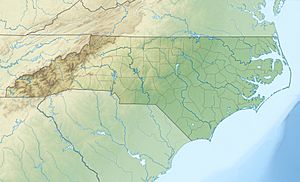Permetter Branch (Brown Creek tributary) facts for kids
Quick facts for kids Permetter Branch |
|
|---|---|
|
Location of Permetter Branch mouth
|
|
| Other name(s) | Tributary to Brown Creek |
| Country | United States |
| State | North Carolina |
| County | Anson |
| Physical characteristics | |
| Main source | divide between Permetter Branch and Buffalo Creek pond about 0.5 miles west of Ansonville, North Carolina 340 ft (100 m) 35°06′37″N 080°07′38″W / 35.11028°N 80.12722°W |
| River mouth | Brown Creek about 2 miles south of Ansonville, North Carolina 210 ft (64 m) 35°04′06″N 080°05′44″W / 35.06833°N 80.09556°W |
| Length | 3.79 mi (6.10 km) |
| Basin features | |
| Progression | southeast |
| River system | Pee Dee River |
| Basin size | 3.89 square miles (10.1 km2) |
| Tributaries |
|
| Bridges | Ansonville-Polkton Road, Mt. Vernon Road, Jacks Branch Road |
Permetter Branch is a small stream, about 3.79 mi (6.10 km) long, located in Anson County, North Carolina. It's known as a "second-order tributary," which means it's a stream that flows into a slightly larger stream. In this case, Permetter Branch flows into Brown Creek.
What's in a Name?
Sometimes, places have more than one name over time. The Geographic Names Information System (a database of names for places in the United States) tells us that Permetter Branch was also once called Palmetto Branch.
Where Does It Flow?
Permetter Branch begins, or "rises," from a pond. This pond is located about 0.5 miles (0.8 km) west of a town called Ansonville, North Carolina.
From its starting point, the stream flows towards the southeast. It continues its journey until it meets Brown Creek. This meeting point is about 2 miles (3.2 km) south of Ansonville, North Carolina.
The Permetter Branch Watershed
A watershed is like a giant bowl of land where all the rain and snow that falls eventually drains into a specific stream or river. The Permetter Branch watershed covers an area of about 3.89 square miles (10.1 km2).
This area gets a good amount of rain each year, around 47.8 inches (121 cm). About half of the land in this watershed, around 50%, is covered by forests. This helps keep the water clean and provides homes for wildlife.



